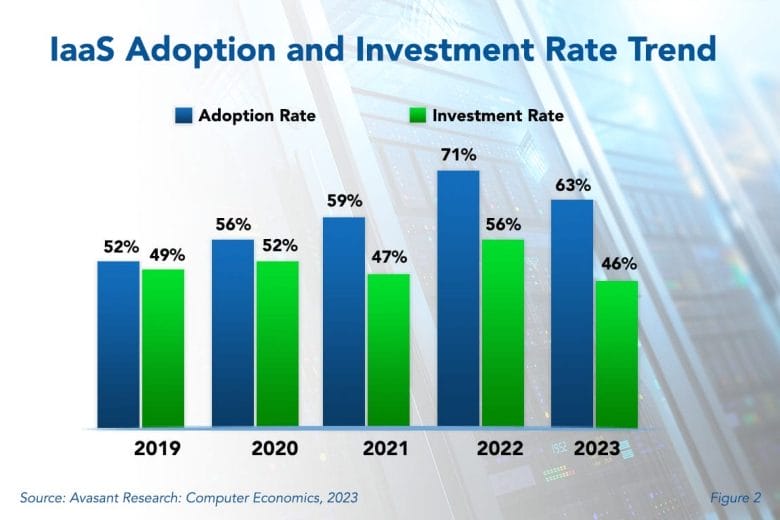The need for agility continues to drive investment in IaaS (infrastructure as a service), and the global pandemic and subsequent supply chain disruptions will likely increase this trend. Cloud infrastructure makes it easier for companies to respond to fluctuations in demand, changes in business requirements, and the need to optimize costs over time. However, as companies embrace more cloud, it can lead to complexity and a need to pay closer attention to total costs. This has led companies to reevaluate their hybrid and multicloud deployments to focus on efficiency and lower operational costs while still pursuing growth.
Figure 2 from our full report, IaaS Adoption Trends and Customer Experience, shows that adoption rates for IaaS have shown a generally increasing trend, while investment rates have fluctuated. In the past five years, adoption (the blue bars) has risen from 52% of all organizations in 2019 to 63% in 2023, after an anomalous spike to 71% in 2022. During the same period, the percentage of organizations making new investments in IaaS (the green bars) has fluctuated with year-to-year differences of up to 9%, finally standing at 46% in 2023.

IaaS refers to the use of network-based computing resources, such as storage and processing, without managing the underlying technical infrastructure. It can be offered in a public cloud or by cloud platform service providers as a private cloud. IT organizations use IaaS for various purposes, including internal production systems, systems development and testing, disaster recovery, customer-facing systems, and handling spikes in demand. As organizations aim to do what is best for the business, hybrid approaches are becoming more desirable.
“Today, most organizations have less than half their servers in the cloud and very few rely solely on public cloud infrastructure providers,” said Waynelle John, a research analyst for Computer Economics, a service of Avasant Research based in Los Angeles. “Combining public cloud with hosted infrastructure and even on-premises systems allows companies to benefit from the best features of each.”
Furthermore, the rising use of FinOps enables organizations to have the most up-to-date view of their spending as it relates to their cloud infrastructure. This allows organizations to initialize chargebacks, enabling ROI to be realized sooner. Therefore, we anticipate continued growth in IaaS adoption and investment. It bears watching how high adoption will go in the next few years.
Nevertheless, in addition to cost risks, security and privacy concerns linger. Some business and IT leaders still worry about security and privacy and trusting the public cloud with confidential information. However, research has shown that IaaS providers generally have superior security to what most companies can achieve in-house.
Based on our survey, this report quantifies the current adoption and investment trends for IaaS and the benefits driving adoption. We assess adoption and investment trends by organization size and sector. We also look at the economics of IaaS by assessing the ROI and TCO experience of organizations that have adopted IaaS and conclude with practical advice for those seeking to gain support for IaaS investments.
This Research Byte is based on our report on this subject, IaaS Adoption Trends and Customer Experience. The full report is available at no charge for subscribers, or it may be purchased by non-clients directly from our website (click for pricing).

